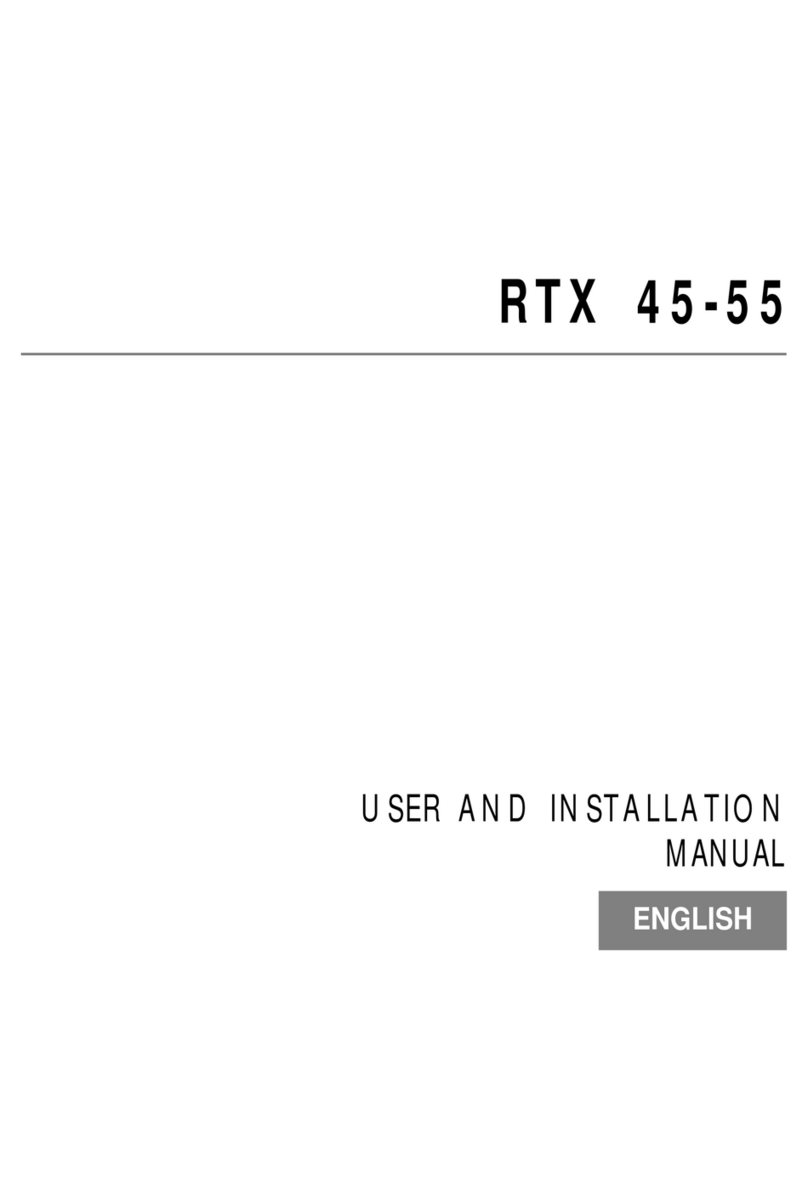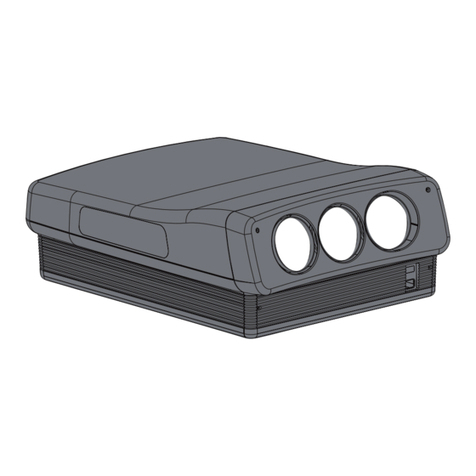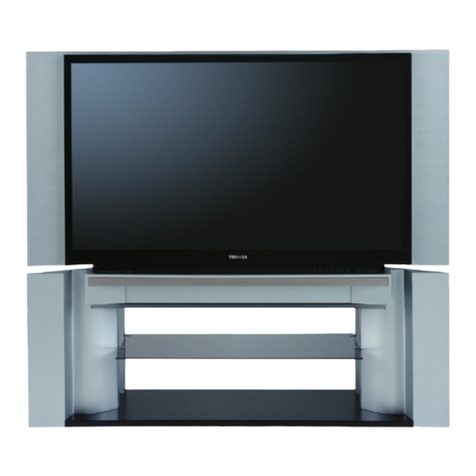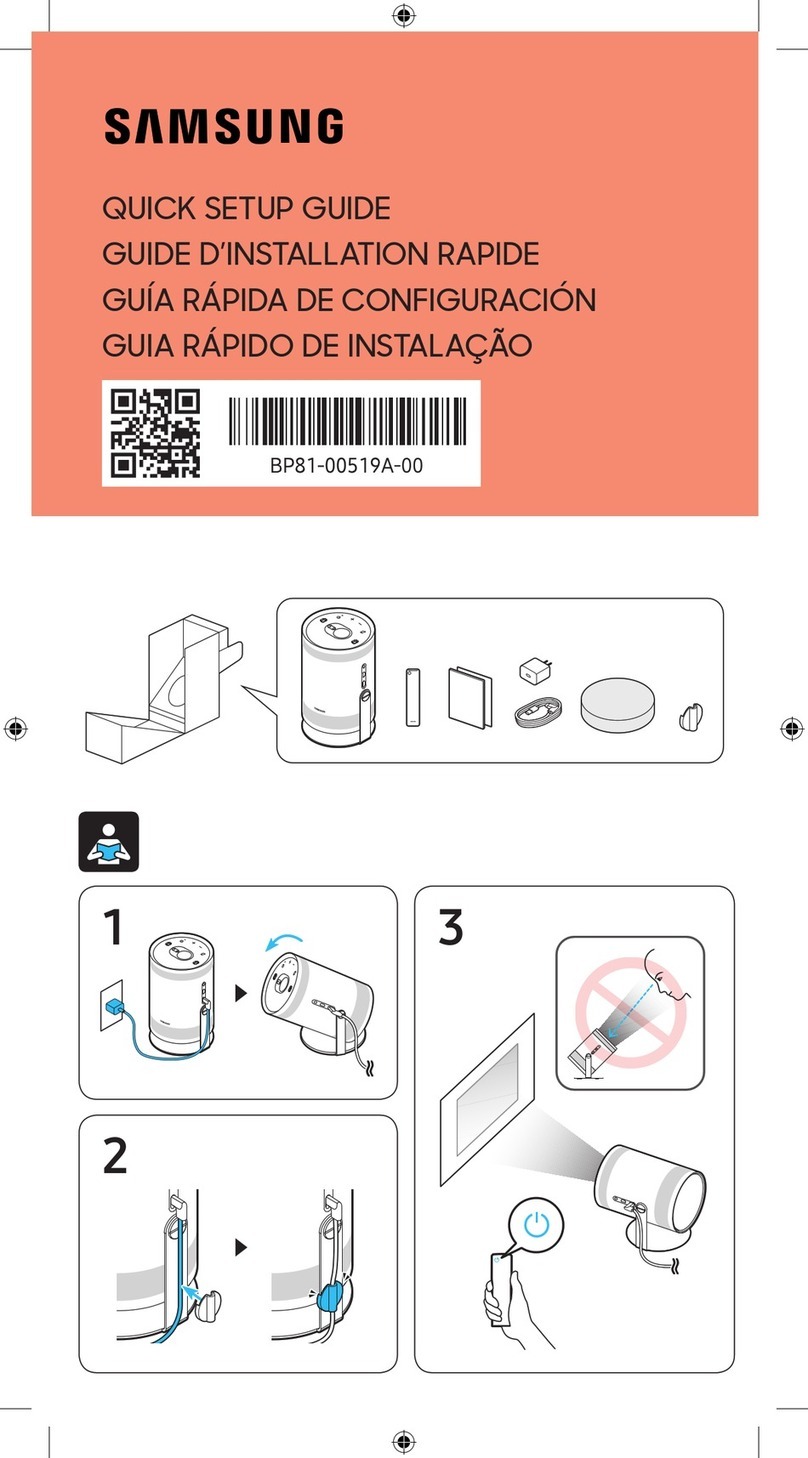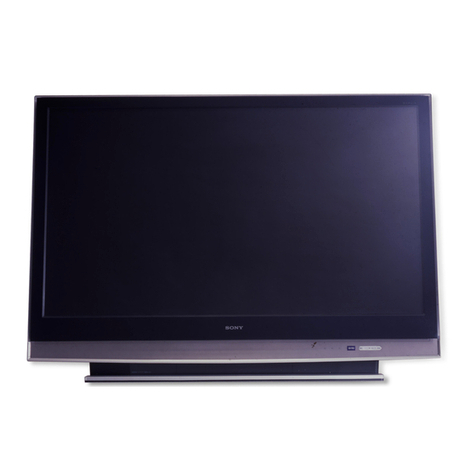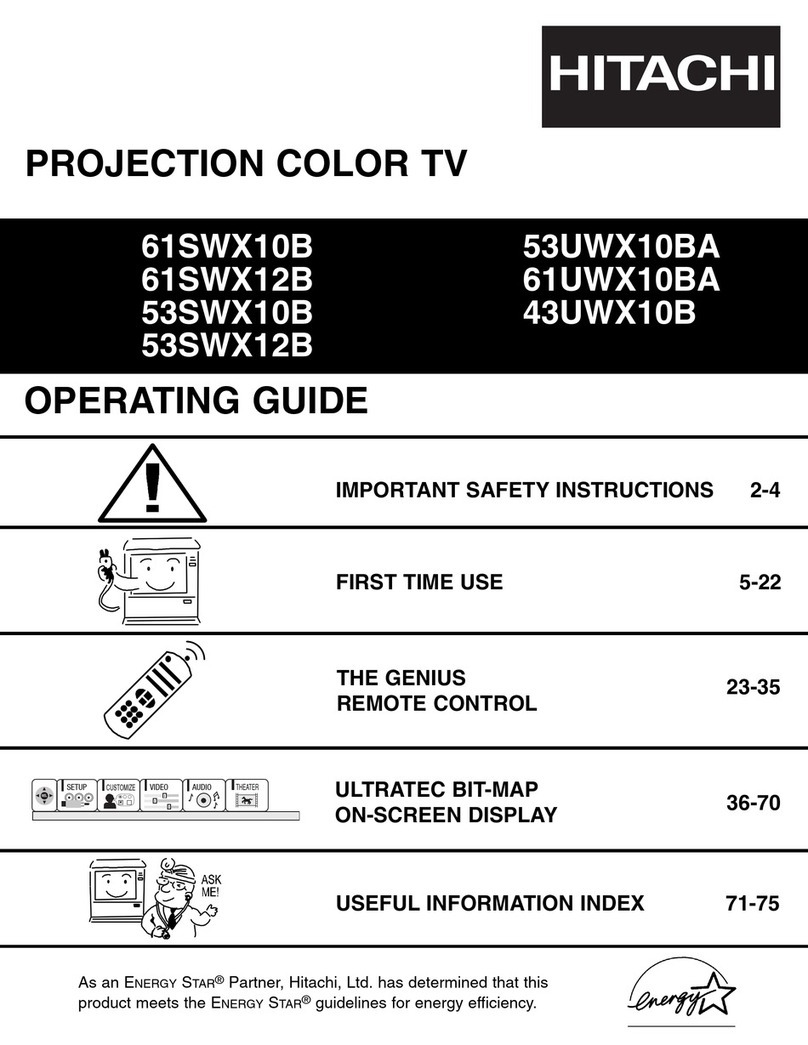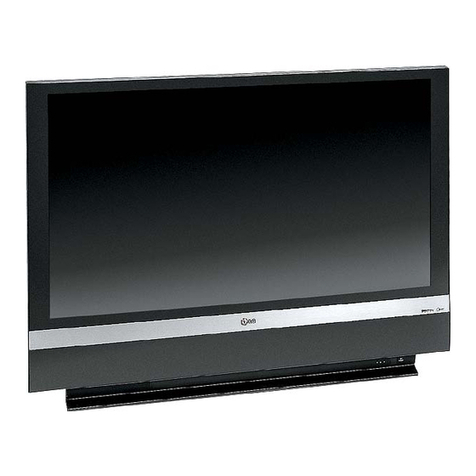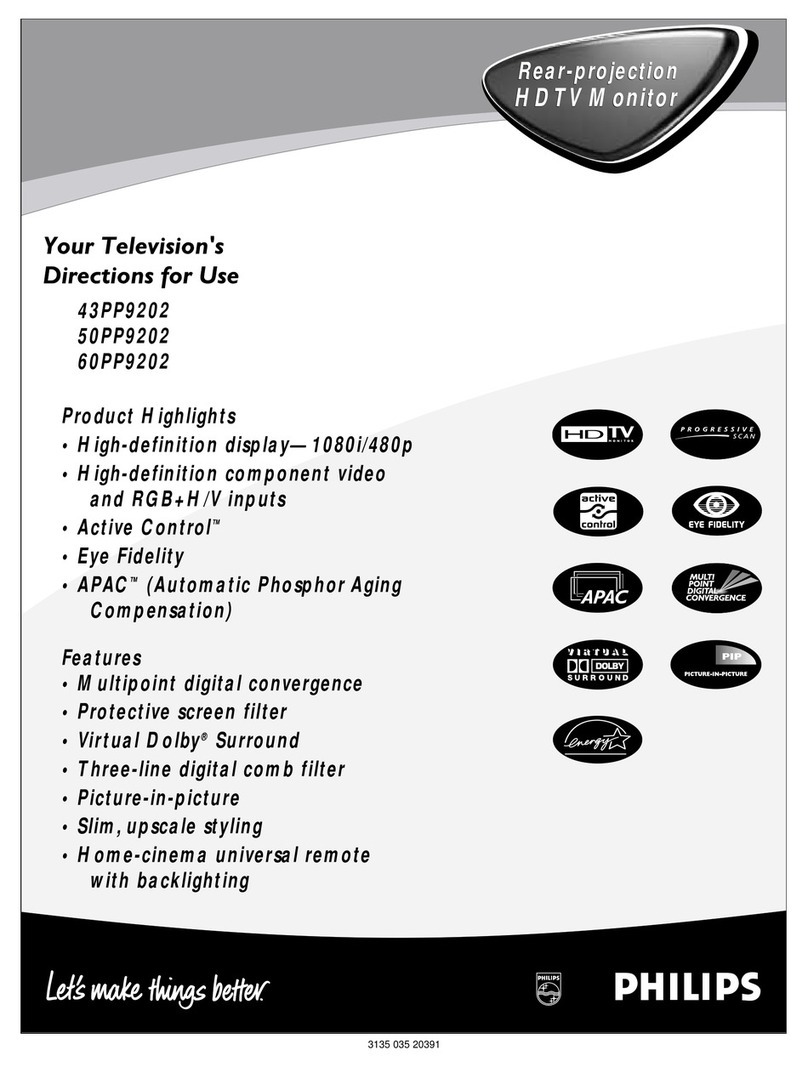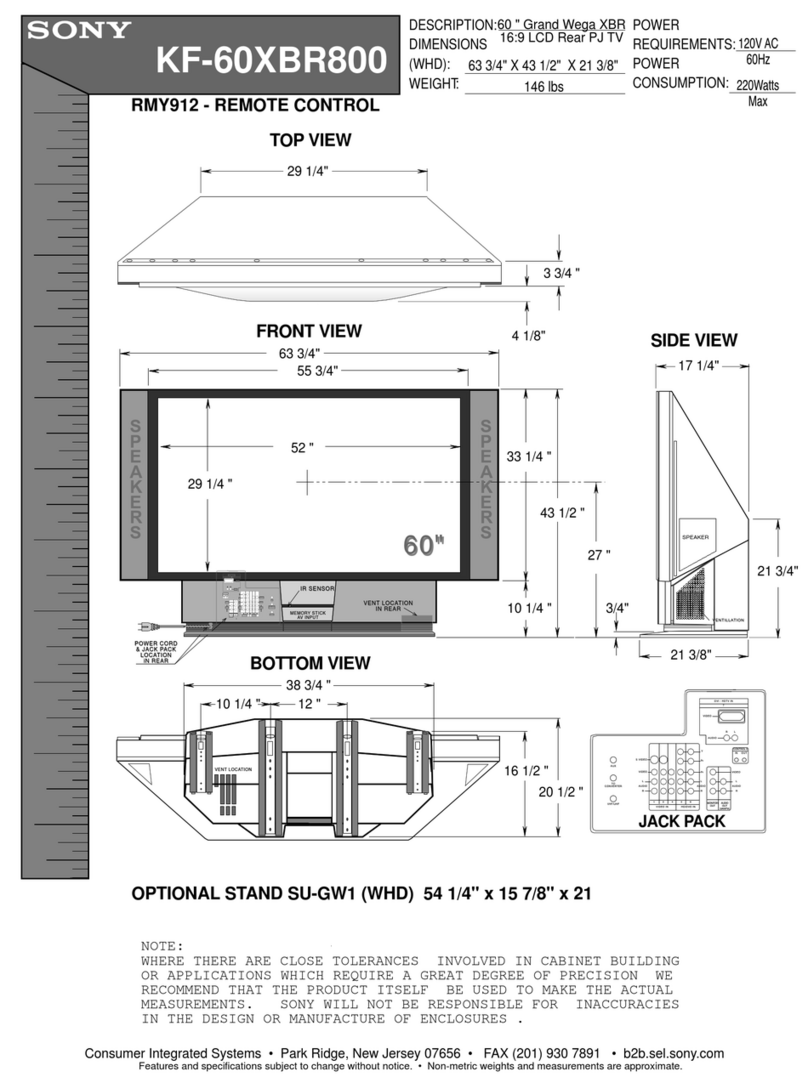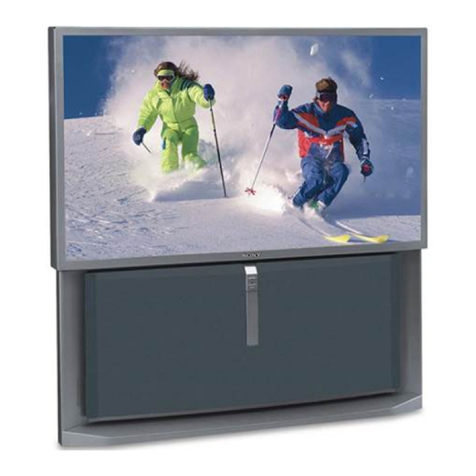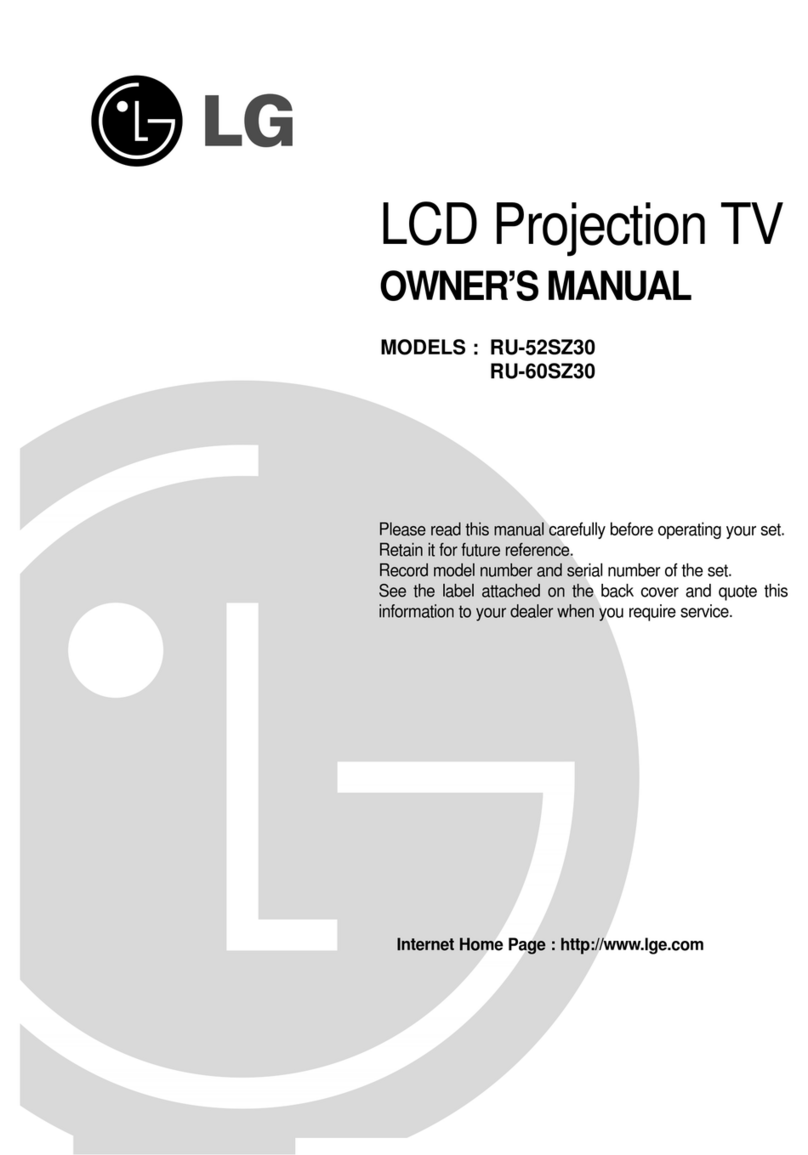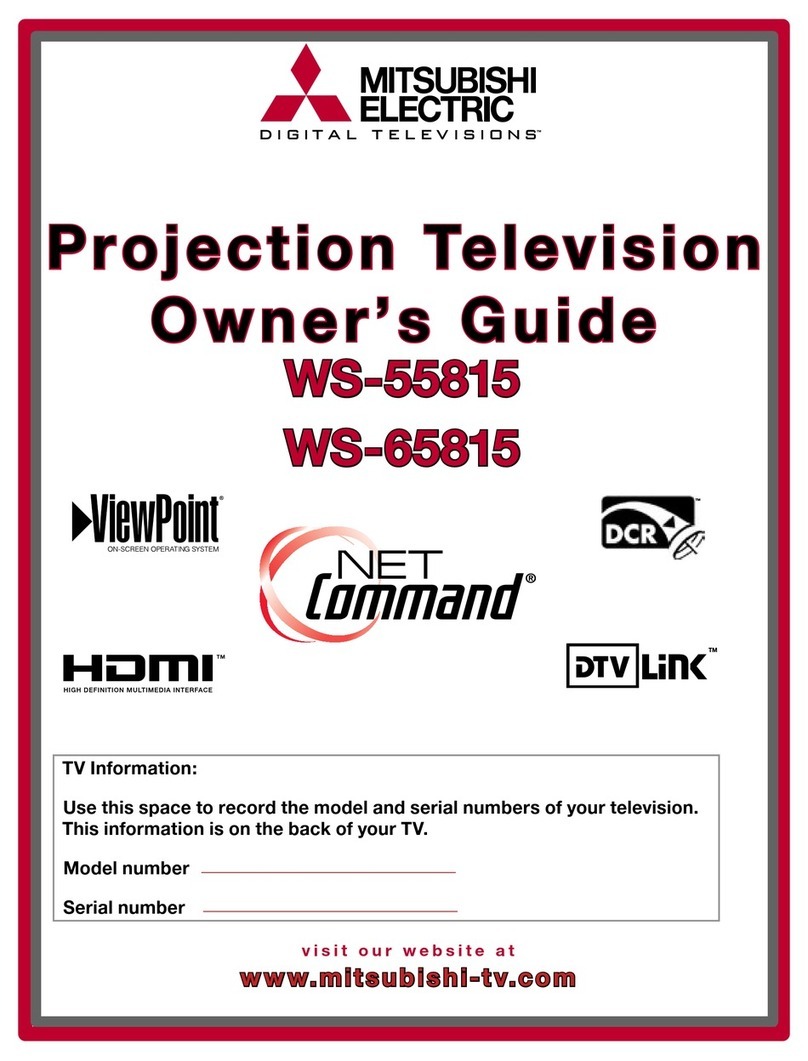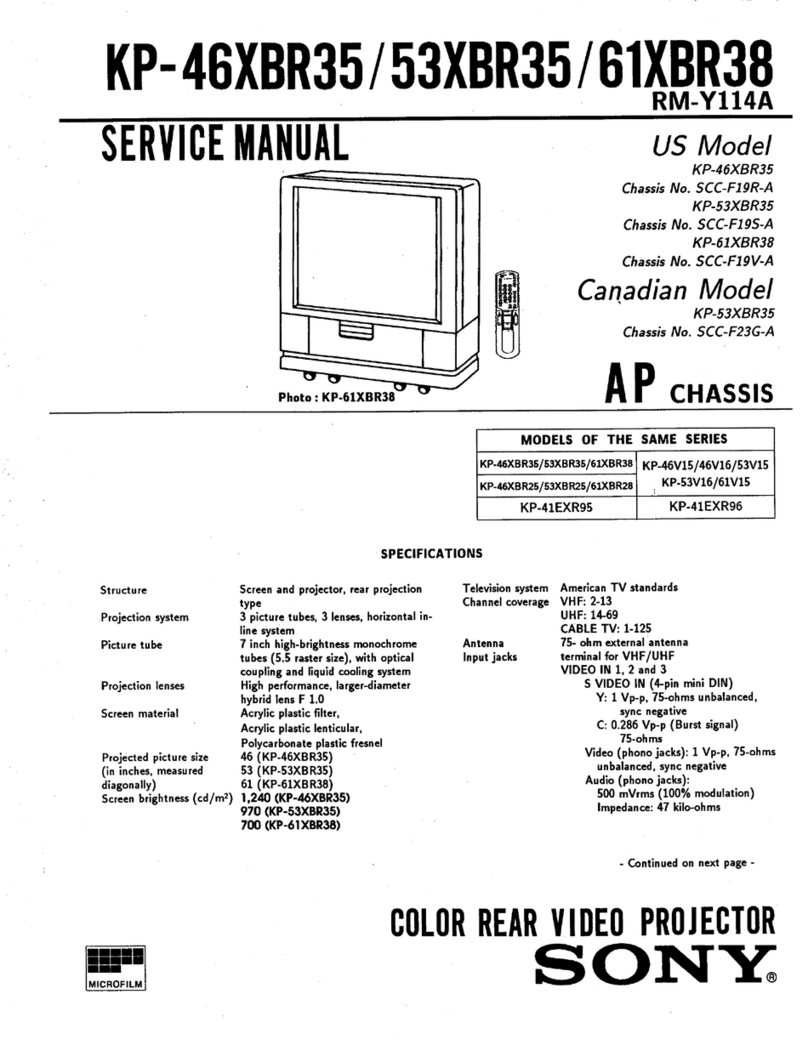Sim2 DOMINO 55M Operating manual

cod. 46.0471.000
User and Installation Manual
DOMINO 55M

REMOTE CONTROL
▲, ▼, ◀, ▶
Navigate through and make adjustments to
the on screen menus.
▲, ▼ SOURCE switches on from stand-by
and calls the Input Selection
menu.
▶ INFO (if pressed in the absence
of the On Screen Display)
calls the
INFO
information
window.
◀ AUTO (if pressed in the absence
of the On Screen Display)
calls Auto Adjust (automatic
optimisation of the image)
.
MENU
Activates the On Screen
Display menus.
Navigates menu pages.
Switches the unit to stand-by.
KEYPAD
MAGNIFICATION
Select lens zoom adjustment.
AUTO
Selects Auto Adjust (automatic optimisation
of the displayed image).
0-9 Keys
Switch on from stand-by and allow direct source
selection.
SOURCE
Displays the Source
Selection menu.
Not active in this model.
MENU -
Activates the On Screen Display menus.
Navigates menu pages.
FREEZE
Freezes a moving picture.
ASPECT
Selects image Aspect ratio.
VCR
Improves the video recorder
signals quality.
INFO
Displays the selected source information
and the projector status.
MEMORIES
Activates Memories menu.
MENU +
Activates the On Screen Display menus.
Navigates menu pages.
Up/Down/Left/Right Arrow keys
Navigate through and make adjustments to the
On Screen menus. Arrow Up/Down activate Quick
menus.
ESCAPE
Deactivates the On Screen Display.
STAND-BY
Switches off to stand-by.
Not active in this model.
2

3
1 INTRODUCTION
Conversion of interlaced video signals to progressive signals by
means of prestigious DCDi™ technology produces fluid, natural ima-
ges free of artifacts such as flicker and stairstepping on diagonals.
Faithful reproduction of signals at higher resolutions (such as high
definition video and graphics) occurs without loss of information or
reduction of image sharpness thanks to the processor’s high pixel
rate signal acquisition capabilities.
Adaptation of the input signal resolution to the Display resolution
occurs without alterations of image quality, in accordance with an
ample choice of aspect ratios, including several definable by the
user.
All image adjustments can be performed from the remote control
with the aid of the On Screen Display; alternatively, the unit can be
controlled by from a home automation system through the serial
port.
The new DOMINO 55M offers an image without any compromise,
with resolution, sharpness, colorimetry and contrast au par with the
one of renowned SIM2 front projector line.
The very latest Texas Instruments DLP™ technology (1280x720
pixel DMD™ panel with 12° technology), a proprietary dust-sealed
optical system, a new six-segment colour wheel and a new type of
Fresnel lens combine to provide a top quality image.
The large number of inputs (1 Composite Video input, 1 S-Video
input, up to 2 Component or RGB inputs, 1 graphic RGB input, 1
DVI-D input, 1 HDMI™ input), ensures the DOMINO 55M supports
and processes a wide range of video signals from various sources:
DVD players, VCRs, satellite and terrestrial receivers, computers,
game consoles, video cameras, etc.
Signal processing capabilities ensure optimum reproduction of a
broad range of input signals, from interlaced video to high definition
and graphics.
Image 12
Set up 14
Menu 14
Memories 15
Info 17
Direct-access adjustments 17
Messages 17
7 TROUBLESHOOTING 18
8 GUIDE 19
A - Additional specification 19
B - Dimensions 20
This manual contains important information on how to install and use this equipment correctly. Before using the equipment, read the safety
prescriptions and instructions carefully. Keep the manual for future consultation.
INDEX
1 PRESENTATION 3
2 IMPORTANT SAFETY INSTRUCTIONS 4
3 INSTALLATION 5
Remote control 6
Audio 6
Connecting video sources 6
4 SWITCHING ON AND OFF 9
Stand-by 9
5 ON SCREEN MENU 10
Inputs 10
Main menu 10
Picture 11
DLP and DMD are registered trademarks of Texas Instruments.
DCDi is a registered trademark of Faroudja, a division of Genesis Microchip, Inc..
HDMI, the HDMI logo and the expression High-Definition Multimedia Interface
are trade marks or registered marks of HDMI licensing LLC

4
ATTENTION:
To reduce the risk of electric shock, disconnect the power
supply cable on the rear panel before removing front (or
back) panel of the unit.
No user-serviceable parts inside. Refer to trained, autho-
rised personnel for technical assistance.
This symbol indicates the possible electric shock
hazard associated with uninsulated live components in the
interior of the unit.
This symbol indicates the presence of important
instructions regarding use and maintenance of the pro-
duct.
2 IMPORTANT SAFETY INSTRUCTIONS
• Federal Communication Commission (FCC Statement)
This equipment has been tested and found to comply with the limits for
a Class B digital device, pursuant to Part 15 of the FCC rules. These limits
are designed to provide reasonable protection against harmful interference
when the equipment is used in a residential environment. This equipment
generates, uses and can radiate radio frequency energy and, if not installed
and used in accordance with the instruction manual, may cause harmful
interference to radio communications. However, there is no guarantee that
interference will not occur in a particular installation. If this equipment does
cause harmful interference to radio or television reception, which can be
determinated by turning the equipment off and on, the user is encuraged to
try to correct the interference by one or more of the following measures:
- Reorient or relocate the receiving antenna
- Increase the separation between the equipment and receiver.
- Connect the equipment into an outlet on a circuit different from that to
which the receiver is connected.
- Consult the dealer or an experienced radio/TV technician for help.
• For customers in Canada
This Class B digital apparatus complies with Canadian ICES-003.
• For customers in the United Kingdom
ATTENTION: This apparatus must be earthed
The wires in this mains lead are coloured in accordance with the following
code:
Green-and-Yellow: Earth
Blue: Neutral
Brown: Live
As the colours of the wires in the mains lead of this apparatus may not
correspond with the coloured markings identifying the terminals in your
plug proceed as follows:
The wire which is coloured green-and-yellow must be connected to the
terminal in the plug which is marked by the letter E or by the safety earth
symbol or coloured green or green-and-yellow.
The wire which is coloured blue must be connected to the terminal which
is marked with the letter N or coloured black.
The wire which is coloured brown must be connected to the terminal which
is marked with the letter L or coloured red.
• Read each chapter of this manual carefully before operating your
unit. Keep this manual for future reference.
• Preliminary adjustments and procedures that necessitate the
removal of the front (or back) panel, must be carried out by
authorised, trained technicians. There are no user serviceable
parts inside.
• To ensure safe and long term reliability please use power cables
supplied with the unit. Observe all warnings and cautions.
• Do not touch internal parts of the unit.
The unit contain electrical parts carrying high voltages and ope-
rating at high temperatures. Do not remove the front (or back)
panel from the unit and refer to qualified service personnel for
all repair and maintenance requirements. The warranty will be
automatically invalidated if the cover is removed from the unit.
• Power supply disconnect device.
The device for disconnecting the unit from the mains power
supply is constituted by the power cable plug. Ensure that the
power cable plugs and the electrical mains socket outlets are
easily accessible during installation operations. To disconnect the
unit from the electric power supply, pull the plug to remove it
from the socket outlet. Do not pull the power cable.
• Use only the specified type of mains power supply.
Connect the unit to a power outlet with voltage rating between
100-240 VAC, 50/60 Hz and with a protective earth connection. If
you are unsure of the type of mains power supply in your home,
consult a qualified electrician. Ensure that the power draw of
the unit is commensurate with the rating of the electrical socket
outlets and any extension cables that are used.
• Protect the power supply cord.
Power supply cord should be routed so that it won’t constitute
an obstruction. Position the power supply cord where it cannot
be reached by children. Install the unit as close as possible to
the power outlet. Do not tread on the power supply cords and
make sure that they are not tangled or pulled; do not expose the
power cords to heat sources; make sure that the power supply
cords are not knotted or kinked. If the power supply cord or plug

5
is damaged, unplug the unit from the wall outlet and request the
assistance of an authorised technician.
• Unplug the unit from the mains power supply during a
lightning storm and when not in use.
To avoid damage to the unit due to lightning and power-line
surges, unplug the unit in the event of electrical storms or when
the unit is left unused for long periods of time.
•
Avoid contact with liquids and exposure to humidity.
Do not use the unit near water (sinks, tanks, etc.); do not place
objects containing liquids on top of or near the unit and do not
expose it to rain, humidity, dripping water or spray; do not use
water or liquid detergents to clean the unit.
• Prevent the unit from overheating.
Do not block any of the ventilation openings. Do not place the
unit near heat sources such as heaters, radiators or other devices
that generate heat (including amplifiers). Do not position the unit
in confined, poorly ventilated places (bookcase, shelves, etc.).
•
Do not expose the eyes to the intense light emitted by the
lamp.
Never look directly at the lamp through the ventilation opening
when the unit is switched on. Risk of eyesight impairment. Ensure
also that children do not look directly at the lamp.
• Position the unit on a stable surface.
To avoid serious injury to persons and damage to property, make
sure the unit is placed on a level, flat and stable surface from
which it cannot fall, tip over or slide. When a cart is used, use
caution when moving the cart/apparatus combination to avoid
injury from tip-over.
• Do not insert objects through the unit openings.
Make sure that no objects are inserted through the openings in
the unit. If this should occur, disconnect the unit from the power
supply immediately and call an authorised technician.
3 INSTALLATION
The packing carton contains the following parts (Fig.1):
• DOMINO 55M monitor
• Remote Control
• 4 1.5 V AAA-type batteries for the remote control
• Three Power Supply Cords
•
Cable for internal speakers inputs (center channel configuration)
• User and Installation manual
Fig.1
If any accessories are missing, contact your Dealer as soon as possible.
The materials used within the packaging correspond with the current
ecological regulations. If you do not have space restrictions we sug-
gest to store the product’s packaging for at least the warranty period.
The DOMINO 55M is designed to stand on the floor, so place it on
a flat, level surface where it has sufficient space for ventilation; to
prevent glare and reflections, avoid places exposed to direct sunlight
or intense light sources.
The mains power input socket and the power switch are both located
on the rear panel. Connect the unit to a power outlet with voltage
rating between 100-240 VAC, 50/60 Hz and with a protective earth
connection.
The unit do not require internal adjustments and do not contain any
user-serviceable parts. Easy maintenance of the air vent - positioned
in the lower end of the DOMINO 55M - may be necessary periodi-
cally. For replacement of the lamp or any other service requirements
seek qualified technical assistance from your nearest Dealer.
A soft cloth is normally sufficient for cleaning the unit. Use a slightly
moistened cloth to remove more stubborn dirt. In this case, before
proceeding switch off and disconnect the unit, and ensure that no
liquid penetrates to the inside.
NOTES: SIM2 carries out comprehensive functional testing in order
to guarantee the maximum product quality. For this reason, when
you start using the product lamp operating hours may already be
at between 30 and 60.
In addition to the regular tests, the Quality Control department
performs additional statistical tests at the time of shipment. In this
case the packing may show signs of having been opened, and the
accumulated lamp operating hours may be slightly higher than the
hours associated with the standard tests.

6
CONTROL
REMOTE CONTROL
The remote control transmits commands to the system by infrared
signals.
The infrared sensor is on the front panel of the DOMINO 55M. Avoid
placing obstructions between the remote control and the infrared
sensor; this will impair the remote control performance.
The remote control requires four 1.5V AAA alkalin e batteries.
Insert the batteries, taking care to match the polarity, as indicated
in the battery compartment in the handset (Fig. 2).
Change the remote control batteries if you experience difficulty in
transmitting commands to the system.
Once discharged, discard the batteries in the proper recycling
bins.
Remove batteries from the remote control if it is to remain unused
for a long period of time to avoid the risk of potentially harmful
chemical leaks.
+-
+-
+
-
+
-
Fig.2
SERIAL PORT (RS-232C)
The unit can be controlled via a personal computer
or home automation systems by means of the serial port.
On request, SIM2 will send you a document containing the serial
port settings and the list of main commands.
AUDIO
It is possible to connect an external Hi Fi audio system to the DO-
MINO 55M’s speakers.
These speakers can be used as:
• left and right channel (Fig.3A)
• center channel (Fig.3B)
four 1.5V AAA-
type alkaline
batteries
CENTRAL
RINTERNAL
SPEAKERS
+
8 � 30W MAX
4 �
15W MAX
L
4 �
15W MAX
-
-+
CENTRAL
RINTERNAL
SPEAKERS
+
8 � 30W MAX
4 �
15W MAX
L
4 �
15W MAX
-
-+
Fig.3A Fig.3B
CONNECTING VIDEO SOURCES
Connect the cables from the video sources to the rear panel of the
DOMINO 55M.
To obtain the best performance from the DOMINO 55M, connect
the various signal sources using good quality cables designed for
video applications (impedance rating: 75 ).
Ensure that:
• the cables are routed in such a way that they do not present an
obstruction to people moving around the room;
• the connectors are inserted carefully to avoid damaging the
pins;
• the cables are not twisted or crushed;
• when disconnecting the cables the connectors are not violently
pulled out of the sockets on the various units.
Video sources (television receivers, VCRs, DVD players, etc.) often
feature several outputs. To obtain the best performance from your
DOMINO 55M, carefully choose which output to use.
Generally, the type of signal offering the best picture quality is HDMI,
followed by DVI-D, RGB, Components, S-Video and Composite
Video, in that order.
However, the DOMINO 55M is equipped with an excellent Video
Decoder and Deinterlacer and therefore even inferior quality signals
will produce high quality results.
Figure 4 shows the types of signals usually available for the most
common types of video sources and the corresponding input con-
nectors to use on the DOMINO 55M.

7
VIDEO
1
This input should be connected to a Composite Video signal (CVBS)
by means of a cable with an RCA connector.
The connector on the source is usually yellow and is frequently
labelled VIDEO.
Although other types of signals are preferable (since they allow
better picture quality), Composite Video signal is still very common,
and nearly all television receivers, video-recorders, DVD players,
camcorders, etc., are equipped with it.
S-VIDEO
2
This input should be connected to an S-Video signal by means of
a cable with a 4-pin mini-DIN type connector.
The corresponding output on the source can be identified by the
labels S-VIDEO or Y/C.
Almost as widespread as Composite Video, S-VIDEO is preferable
because it offers a clearer and sharper picture.
COMPONENT / RGBS
3
4
These inputs are composed of two sets of 5 RCA connectors.
Each set of connectors is suitable for RGB and Component si-
gnals.
- RGB signals can have the following sync signals: composite sync
on the green signal (RGsB), H+V Composite Sync, or separate
H/V Sync.
Connect the R, G, B outputs of the source to the respective R, G,
B inputs of the DOMINO 55M (paying attention not to invert the
positions) and synch signals to the HV input or the H and V inputs.
When connecting the three sets of RCA connectors use the colours
as a guide: connector R is red, G is green, B is blue, H/HV is white
and V is black.
By using a suitable SCART to RCA (or BNC) connector adapter
cable, an RGB video signal from a source equipped with an SCART
connector can be connected to this input.
- Component signals should be connected to inputs Y, Cr and Cb,
taking care to observe the correspondence with the outputs on the
source. Since sources outputs are labelled in various ways, refer
to Table 1 to establish the correspondence between the various
signals. The connector colours can also be of help, as shown in
the table.
The video signals that can be connected to this input can have
horizontal scanning frequencies of 15 kHz (standard video resolu-
tion), 32 kHz, or higher (progressive scanning video, high definition
video).
Table 1
Progressive signals usually provide better quality than interlaced
signals, but if the source features both progressive and deinter-
laced signal outputs it is good practice to compare the quality of
the pictures reproduced by the DOMINO 55M in the two cases:
deinterlacing performed by the DOMINO 55M (thanks to Faroudja
DCDi™ technology) is often more effective than that performed at
the source.
GRAPHICS RGB
5
This input should be connected to an RGB-type video or graphic
signal using a cable with a DB15HD type connector.
The signal source device (typically a personal computer or game
console) must be able to provide separate H/V synchronisation or
composite H+V.
The video or graphic signals that can be connected to this input
can have horizontal scan frequencies (H-sync) of between 32 and
80 kHz and a vertical frequency (V-sync) of between 48 and 100
Hz. Image resolution can vary between 640x480 and 1600x1200
pixels (VGA, SVGA, XGA, SXGA, UXGA).
DVI-D
6
If your source is equipped with DVI-D output (increasingly present
on the latest PCs) you can take advantage of the better picture
quality this connection provides.
HDMI
7
The HDMI™ (High Definition Multimedia Interface) integrates an
uncompressed high definition video signal with a multichannel
audio signal and allows the exchange of control data between the
video source and the DOMINO 55M. The HDMI™ input provides
connection to video sources that use the HDCP (High-Bandwidth
Digital Content Protection) protocol to protect contents.
Once the video source has been connected to the HDMI™ input,
internal processing by the DOMINO 55M separates the video
information from the audio information. Audio information is then
made available via an optical digital output with a female TOSLINK
connector in accordance with the S/PDIF standard.

8
Fig.4
Computer
DVD Player
Television receiver
HDTV receiver
Videorecorder
Camcorder
Game console
Television receiver
DVD Player
Videorecorder
Camcorder
Game console
AUDIO
OUT
VIDEO R/Cr G/Y B/Cb HV V
13
S-VIDEO R/Cr G/Y B/Cb HV V
2
GRAPHICS RGB CONTROL (RS 232)
5
7
DVI-D
6
4
INPUT
1
2
3
4
5
6
7
Computer DVD Player
HDTV receiver

9
DOMINO 55M power switch is on the rear panel (Fig.5).
I
O
Fig.5
Once the power switch is on the “I” position, the unit will initialise
and execute a test routine. Soon after the unit will enter stand-by
mode (Table 2).
Front panel LEDs placed show the status of the unit.
Table 2
If the status is “Error” the unit cannot be operated; if the status is
“Warning” the unit will operate but it may be unable to read certain
input signals correctly.
STAND BY
Switching On (Fig.6):
MENU
Fig. 6
• from the Remote Control (keys 0-7)
• from the front panel Keypad (keys ▲ and ▼)
Pressing a key from 1-7 on the remote control selects the corre-
sponding input; pressing 0 (or one of the keys ▲ and ▼ on the front
panel) selects the input that was active at the time the unit was last
switched off. Typically, the picture will appear after 15-20 seconds. If
the unit is switched on soon after it was last switched off, the lamp
may fail to come on because it is too hot. In this case just wait a
few minutes to allow the lamp to cool.
Switching Off (Fig.7):
MENU
Fig. 7
• from the Remote Control (key )
• from the front panel Keypad (key ).
4 SWITCHING ON AND OFF

10
If you wish to power off the unit completely, wait at least one mi-
nute in stand-by to allow the unit to cool before setting the mains
All the functions of the DOMINO 55M can be activated from the
keypad or remote control with the aid of a practical and comprehen-
sive system of on screen menus.
INPUTS
The input selection menu (
INPUTS
) is called by pressing 0 on the
remote control and, when no other menu is displayed, using the
▲ and ▼ keys on the keypad. To select an input, scroll through the
list with the ▲ and ▼ keys until the required input is highlighted,
then press ▶.
Display of the input selection menu is terminated by pressing the
ESC
key, or when the On-Screen Menu display timeout (set in the
MENU
Menu) has elapsed.
Inputs 3 and 4 can receive RGB and YCrCb signals, either at 15 kHz
or at 32 kHz or higher. The association between the input and the
type of signal is made from the pull-down menu that appears on
the right of the < symbol after pressing the ◀ key (Fig. 8).
In the pull-down menu it is also possible to select the AutoSync
option; in this case the DOMINO 55M automatically recognises the
input signal horizontal frequency (15KHz, 32KHz or higher).
After selecting the source signal (by means of the ▲ and ▼ keys),
press
MENU+/MENU -
to confirm and close the pull-down menu; the
value you have just entered will be displayed on the right of the <
symbol. As with the other inputs, you can now select the input just
set by pressing the ▶ key.
Inputs
1 VIDEO 1
2 S-VIDEO 2
3 COMP/RGB 3
4 COMP/RGB 4
5 GRAPH RGB 5
6DVI-D 6
7HDMI 7
YCrCb
YCrCb
RGBS 15kHz
1
2
3
4
5
6
7
Fig. 8A
Inputs
1 VIDEO 1
2 S-VIDEO 2
3 COMP/RGB 3
4 COMP/RGB 4
5 GRAPH RGB 5
6DVI-D 6
7HDMI 7
YCrCb
YCrCb
RGBS 15kHz
1
2
3
4
5
6
7
YCrCb AutoSync
YCrCb 15KHz
YCrCb
RGB AutoSync
RGB 15KHz
RGB
Fig. 8B
Also Input 6 (DVI-D) is capable of receiving YCrCb or RGB signals:
as above, the selection should be made from the drop menu that
appears on the right of the < symbol.
Once the input has been selected, a brief phase starts during
which the unit analyses the the applied signal. During this interval
a box appears with an indication relative to the signal requested.
As soon as the as the unit locks on to the signal and the picture is
displayed, a box with additional information may be displayed or
not, according to the value of “
SOURCE INFORMATION
” adjustment in
“
MENU
” section.
MAIN MENU
To access the main On Screen Display menu, press the
MENU
key
on the keypad or the
MENU+
or
MENU-
key on the remote control.
The main menu is divided into four windows,
PICTURE, IMAGE
,
SETUP
and
MENU
. Use ▲ and ▼ to select the line corresponding to the
adjustment you wish to make (Fig. 9).
The various menus offer only the relevant adjustments in accordance
with the type of input signal displayed (e.g. adjustments that are
typical of video signals do not appear on the menus when a signal
from DVI input is selected).
Some adjustments (e.g.
BRIGHTNESS
and
CONTRAST
) are associated
with a numerical value that can be varied within the set limits using
the ◀ and ▶ keys.
5 ON SCREEN MENU
power switches to the “O” position or unplugging the power supply
cables.

11
Picture
Contrast
Color
Tint
Sharpness
Filter
Cinema Mode
Video Type
50
50
50
3
2
Off
Normal
Auto
Auto
VCR1
VCR2
Noise Reduction
Brightness 60
Fig. 9
For others (e.g.
VIDEO TYPE
) you can choose between two or three
options presented on the same line (and selectable using the ◀
and ▶ keys). Other adjustments (identified by the < symbol) are
associated with submenus, which appear as a superimposed window
in which the selection is made with the ▲ and ▼ keys (Fig.10).
Fig. 10A
Fig. 10B
These submenus are accessed by pressing the < key. To quit the
submenu and return to the higher level press the
MENU+/-
keys.
Press
ESC
on the remote control or keypad to abandon the menu
display or wait for it to disappear automatically after the number of
seconds set in the
SETUP
page.
PICTURE
This menu features the adjustments related to picture quality.
Adjustments that are not available for a specific input will not be
displayed on the menu. Table 3 summarises the adjustments
available for each input.
BRIGHTNESS
Use this control to adjust the darker areas of the picture (black
level), without significantly affecting bright areas. For correct adju-
stment it may prove useful to display a grey scale with at least
twenty bands.
Now try to reduce the brightness of the black band as much as possi-
ble while ensuring that it can still be distinguished from the adjacent
band with brightness slightly higher than black. Alternatively use a
scene composed of black objects alongside other dark coloured
objects and try to keep all the objects separately identifiable.
CONTRAST
Use this control to adjust the brighter areas of the image (white
level), without significantly affecting dark areas. For correct adju-
stment it may prove useful to display a grey scale with at least
twenty bands.
Now try to increase the brightness of the white band as much as
possible while ensuring that it can still be distinguished from the
adjacent band with brightness slightly less than white. Alternatively
use a scene composed of well-lit white objects surrounded by light
coloured objects with lower level lighting, and try to ensure that all
the objects remain separately identifiable.
COLOUR
This control (also called Saturation) increases or decreases the
picture colour intensity. When set to zero, colour images will be
shown in black and white. Increasing the value, try to find the point
at which the colours look natural: suitable references include skin
tones and grass in landscape shots.
TINT
Controls the purity of colours. Basically determines the red-green
ratio of the picture.
Reducing the value will boost the red contents of the picture, in-
creasing it will boost the green tones. For this adjustment use skin
tones or a test image with colour bars as a reference.
SHARPNESS
Use this adjustment to increase or decrease the level of picture de-
tail. When the sharpness value is reduced the image details appear

12
less pronounced, while increasing the value raises image definition,
making the outline of objects sharper. Note that an excessively high
value may result in a ‘noisy’ picture and the edges of objects may
appear unnaturally clearly defined.
SHARPNESS MODE
This allows you to select the type of processing associated with
sharpness adjustment. In the case of a progressive or interlaced
video signal
VIDEO
mode is advisable; with PC graphic signals use
GRAPHIC
mode.
FILTER
This allows you to select the mode in which the input signal is
processed. Selecting the most appropriate value for a given input
signal ensures the best horizontal and vertical definition and makes
the picture sharper.
CINEMA MODE
This control selects the deinterlace algorithm applied to the input
signal. Select
AUTO
mode to analyse signal characteristics and
apply the correct deinterlace mode automatically. Use this op-
tion if the video signal source is a movie film (obtained from a
Teleciné device with 3:2 or 2:2 pull-down). Select
NO
to apply a
Motion compensated algorithm optimized for video camera signals.
VIDEO TYPE
This control inserts a filter that improves stability of images from
videorecorders or DVD players. To toggle between
NORMAL, VCR1
and
VCR2
modes, press the
VCR
key on the remote control or select
values on the On Screen Display.
NOISE REDUCTION
Use this adjustment to select the noise reduction filter value. When
the option is selected in the menu the picture is divided into two.
On the left hand side the picture is not affected by the filter while
the filter is active on the right hand side; this makes it possible to
compare the changes resulting from noise filtration with a clean
unfiltered image. It is possible to deactivate the filter
(NOT ACTIVE)
using the automatic
(AUTO)
setting or manually
(MANUAL
) selecting
the most suitable value for the picture with the
VALUE
adjustment.
In this latter case it is sufficient to position the cursor under the
values and make the required setting with the ▲ and ▼ keys on
the remote control.
Table 3
IMAGE
This menu features adjustments relating to picture position, aspect
ratio, magnification etc.
ASPECT
This adjustment allows you to change the dimensions and aspect
ratio (relationship between width and height) of the displayed ima-
ge. There are five preset aspects available and three personalised
aspects (with user-settable parameters). You can select a different
aspect for each source: the selected aspect ratio will be automatically
called the next time the relative source is called. You can also select
the required aspect ratio by repeatedly pressing the key, or by
pressing and a numerical key (1...8).
The following aspects are available.
NORMAL:
projects the image occupying the full height of the screen
while maintaining the aspect ratio of the input signal. When the input
signal aspect ratio is 4:3 black vertical bands are displayed on the
right and left of the picture.
ANAMORPHIC:
allows a 16:9 picture to be displayed correctly.
LETTERBOX:
serves to display a 4:3 letterbox image (with source signal
having black bands above and below the picture) so that it fills the
16:9 screen and maintains the correct aspect ratio.

13
(no overscanning) and 32 (maximum overscanning). The resulting
image always maintains the selected aspect irrespective of the
selected overscan value.
POSITION
Use this adjustment to position the image vertically and horizontally.
These parameters do not normally require adjustment because the
unit examines the input signal and automatically sets the most suita-
ble values. However, if the image is not perfectly centralised it may
prove useful to repeat the input signal analysis and the consequent
image positioning procedure. This automatic control procedure is
activated by pressing
AUTO
key on the remote control (or the ◀ key
on the front panel keypad when the OSD is not displayed). When
this procedure is called it is helpful to have a white or light coloured
background on the screen in the current picture.
FREQUENCY/PHASE
These adjustments, available for progressive signals and for signals
from a PC, ensure correspondence between the number of pixels
making up the signal and the number of pixels that make up the
image.
These parameters do not normally require adjustment because the
unit examines the input signal and automatically sets the most
suitable values. However, if the image appears disturbed (loss of
resolution within equidistant vertical bands or instability and lack of
sharpness on narrow vertical lines) it may help to prompt the unit to
repeat the input signal analysis and consequent determination of the
frequency and phase parameters. This automatic control procedure
is activated by pressing key
AUTO
on the remote control (or the ◀
key on the front panel keypad when the OSD is not displayed).
If the automatic procedure fails to have the required effect, enter the
frequency and phase values manually and move sufficiently near to
the screen to observe the effects of the adjustments.
Y/C DELAY
In the case of Video and S-Video signals, it may be necessary to
correct horizontal colour misalignment within the image.
For a given video standard (e.g. PAL or NTSC) the stored value
does not normally require further fine-tuning, unless the source or
connection cable is changed.
PANORAMIC:
stretches the 4:3 image, slightly cropping the upper and
lower parts. Panoramic is ideal for displaying a 4:3 image on the
16:9 screen of the Display.
PIXEL TO PIXEL
: displays the image as it is input without adapting it
to the screen.
The image is displayed in the centre of the screen and if its hori-
zontal and/or vertical dimensions are smaller than the display, it is
bounded by vertical and/or horizontal black bands.
USER 1, 2, 3
: when none of the preset formulas are suitable, three
User controls are available, with the facility for continuous horizontal
and vertical adjustment of picture size.
COLOUR TEMPERATURE
Changes the colour balance of the image and is referred to the
colour temperature of white.
Colours can be adjusted towards the red end of the spectrum (low
colour temperature values - expressed in degrees Kelvin) or the
blue end (high values). Colour temperature can be selected with
three preset values:
HIGH, MEDIUM
and
LOW
. In addition, a
USER
setting
is provided in which the user can set the white point by making
separate adjustments for Red, Green and Blue.
Generally, the
HIGH
value is more suitable for displaying graphic
images, while
MEDIUM
and
LOW
values are preferable for video
images.
GAMMA CORRECTION
Determines the response to the grey scale, emphasising or atte-
nuating the different grades of brightness (blacks, dark, medium,
light grey, whites) in the image. The
GRAPHIC
setting is more suitable
for computer images, while the
VIDEO
and
FILM
settings are more
suitable for video images.
OVERSCAN
Eliminates irregularities around the outer borders of the image.
Certain relatively inaccurate sources can produce an image with
more or less pronounced irregularities around the outer edges;
thanks to the overscan function these imperfections can be moved
to outside the displayed area. Overscan values can be between 0

14
Table 4
SETUP
The setup menu contains less frequently used adjustments that may
be required during installation (e.g. the display of Test Patterns).
POWER ON
If selected (
AUTO
), this option allows the unit to be switched on
directly from the mains power supply once the initialisation phase
is terminated.
If disabled (
STAND BY
), at the end of the initialisation phase the unit
assumes Standby status and awaits the power-up command from
the remote control or keypad.
TEST PATTERNS
Displays a series of four test patterns, which are useful when installing
the system and checking basic functions (Fig. 11). Use the ▼ and ▲
keys to browse through the test patterns
Fig.11
INITIAL SETTINGS
Restores original factory settings except for
POSITION, ORIENTATION,Y/C
DELAY, ZOOM
and
FOCUS
. Confirmation will be requested prior to
executing the operation.
MENU
LANGUAGE
Lists the languages available for the On Screen Display menus.
SOURCE LIST
The functions described below make it possible to modify the
inputs selection menu (
INPUTS
, which is called by pressing the 0
key) and adapt it so that it matches the requirements of the user
more closely.
The
SOURCE LIST
page displays all the inputs physically present on
the DOMINO 55M.
If you want not to show in the
INPUT
menu an input you do not use,
select
SOURCE LIST
and position the cursor on the line corresponding
to the input you wish to hide. Now press the ◀ key and select deac-
tivation of the relative source (Fig.12). Of course you will always be
able to activate again a source that has been deactivated before.
The deactivation or activation of the source results in automatic
renumbering of the remaining active sources.
Active video signal sources (shown in the inputs selection menu)
are distinguished by tick symbols.
2 S-VIDEO
5 GRAPHICS RGB
6
3 COMPONENT / RGBS
4 COMPONENT / RGBS COMPONENT / RGBS
1 VIDEO
1
2
3
4
6
7
5
DVI-D
S-VIDEO 3
GRAPH RGB 5
DVI-D 6
COMP RGB 5
COMP RGB 4COMP RGB 4
VIDEO 1
S-VIDEO 4
7 HDMI HDMI 7
Source list
ACTIVE
NAME
Yes No
Fig.12
You can also identify the input with a more significant name for the
user (e.g. with the name of the connected device). For this purpose,
after selecting the display of a given input, select the option
NAME
in the pull-down menu. To assign a name to a source you can use
up to twelve alphanumeric characters (for more details refer to the
following section).
Text insert
Characters are entered using a specific text input menu (Fig.13). This
menu provides the facility to store text strings easily and quickly.

15
OSD POSITION
Serves to position the On Screen Display within the screen area.
The OSD can be positioned using the arrow keys for fine adjust-
ments or keys 1...9 on the remote control to select one of 9 preset
positions.
MEMORIES
The main picture parameters can be saved in discrete sets of values
called “
MEMORIES
” so that they can be subsequently applied as a
group using a single command.
3 separate Memories (Memory 1, Memory 2, Memory 3) are avai-
lable for each of the 14 types of signals:
for a total of 42 memories.
The image parameters that can be stored/retrieved by the Memories
management system are as follows:
Picture Image
BRIGHTNESS ASPECT
CONTRAST COLOR TEMPERATURE
COLOR COLOR TEMP. (R/G/B)
TINT OVERSCAN
SHARPNESS GAMMA
FILTER
SHARPNESS MODE
VIDEO TYPE
NOISE REDUCTION
Some of these parameters may not be available for certain inputs or cer-
tain input signals, in accordance with the definitions in Tables 3 and 4.
Fig.13
Text input mode is same whether you are editing an existing
name or entering a name for the first time. Characters can be
inserted in any of the available positions (represented by ho-
rizontal lines). Use the ◀ and ▶ keys to move the cursor left
or right respectively. Press the numerical key corresponding to
the character (Fig. 13); the first press selects the first character,
the second press selects the second character, and so forth.
Once you have entered a character, to enter the next character move
the cursor to a position immediately to the right by means of the ▶
key control and repeat the procedure described above.
Use the ▲ key to switch from upper case to lower case characters.
To delete any errors move the cursor to the incorrect character and
press the ▼ key.
Once you have terminated the text input procedure confirm your
text and save it by pressing the
MENU+
key on the remote control.
If you want to cancel the changes you have made press the
MENU-
key.
SOURCE INFORMATION
When active (
YES
), each time the source is changed a box is displayed
with information relative to the signal type. When disabled (
NO
) this
box does not appear.
OSD BACKGROUND
Determines the type of background for the On Screen Display.
OSD TIMEOUT
Determines the On Screen Display timeout. When the On Screen
Display appears it will remain displayed for the time set in this
parameter starting from the time the last key was pressed. The
adjustment is made using the ◀ (decrease) and ▶ (increase) keys
within a 5-60 second timeframe.

16
memory is associated with the specific source and signal type and
called automatically whenever that specific combination of source
and signal type is selected.
SAVE INITIAL SETTINGS IN MEMORIES
To restore the original values of a previously modified Memory,
select the line relative to the Memory in question and open the
corresponding drop-down menu ( ◀ key). Select the line
SAVE INITIAL
SETTINGS
. To confirm the operation, the message ‘
INITIAL SETTINGS
SAVED IN MEMORY 1
’ is shown at the bottom of the display and the
letter “I” appears to the left of the memory name.
RENAME MEMORIES
All Memories can be named. To enter a name (maximum length of
12 alphanumeric characters) select the option
RENAME
in the relative
drop-down menu. The text is input in accordance with the
method described in the heading “
TEXT INSERT
”.
RESTORE CURRENT VALUES
When you open the
MEMORIES
menu a copy of the current settings
is saved in a temporary memory (designated by 0 -
AUTO
). After
having retrieved one or more memories you can restore the set-
tings existing at the time you opened
MEMORIES
menu by selecting
Memory ‘0’ (
0 - AUTO
). Note that this operation must be executed
before the
MEMORIES
menu page disappears (30 seconds after the
final operation with the remote control or keypad). The next time it
appears, in fact, the temporary memory will contain new informa-
tion that takes account of any Memories that were selected in the
penultimate access to the
MEMORIES
page.
Memory 0 can be used also when you do not wish to enable
Memories management for the signal in use. In effect, once Memory
‘0’ is selected, when a source is chosen the unit will automatically
reload the settings that were active the last time the source was
displayed.
INFO
Displays information concerning the displayed video/graphic signal
and the operating status of the unit.
This function is displayed on pressing the key on the remote
control (or, in the absence of the On Screen Display, the ▶ key on
the keypad).
Pressing the key on the remote control (Fig.14) serves to activate
the menus management menu page.
F1
E
2005
Fig.14
The available operations for each selected memory are described
below.
SAVE MEMORIES
To save the parameter current values in Memory 1, move the cursor
to line ‘1’ with the ▲ and ▼ keys, and open the pull-down menu by
pressing the ◀ key (Fig.15). Select the line
SAVE CURRENT SETTINGS
.
To confirm the operation, the message
‘CURRENT SETTINGS SAVED IN
MEMORY 1’
is displayed at the bottom of the screen and the letter ‘S’
appears to the left of the memory name. Memories 2 and 3 can
be saved using the same procedure.
Fig.15
RECALL MEMORIES
To retrieve memories select the required line and press the ▶ key.
The parameters stored in the selected memory will be applied to
the displayed image, while a confirmation message (‘
MEMORY 1
RECALLED’
) will be displayed to confirm the operation. The retrieved

17
DIRECT-ACCESS ADJUSTMENTS
FREEZE
Allows you to freeze the displayed image (press remote control
key). Press the key once again to restore normal viewing .
MAGNIFICATION
Allows you magnify a selected area of the image.
The degree of enlargement is selected in Zoom mode (identified
by the symbol in the centre of the image) using the ◀ and ▶ keys.
The area of the picture to be enlarged is selected in Pan mode (
symbol in the centre of the picture) using the ◀, ▶, ▲ and ▼ keys.
You can toggle between Zoom and Pan mode by pressing the
key on the remote control.
QUICK MENUS
Quick menus provide access to the main adjustments that affect
image quality without calling the main menu.
BRIGHTNESS, CONTRAST, COLOUR, TINT, SHARPNESS
and
FILTER
adjustments
appear at the bottom of the screen one after the other when the
▲ and ▼ keys are pressed.
MESSAGES
The following messages may appear during operation of the unit:
No Signal
The DOMINO 55M does not recognise any signal applied to the
selected input. In this case:
• Make sure the selected input is connected to a video or graphic
signal and that that source is functioning correctly.
• Check the condition of the cables used to connect the unit to
the various sources.
• Make sure the video or graphic signals supplied by the source
are compatible with the unit’s technical specifications and, in
particular, with those of the selected input.
Out of Range
This message appears when either the resolution or the vertical/
horizontal frequency of the input signal exceeds DOMINO 55M spe-
cifications (e.g. a QXGA graphic signal) or when an input is supplied
with an incompatible signal (e.g. after setting the components input
to YCrCb 15kHz a progressive signal is connected).

18
7 TROUBLESHOOTING GUIDE
No power (LEDs always OFF)
• Check that the units’ power switches are set to ‘I’.
•
Check that the power cables are correctly connected to the unit
power sockets.
•
Check the condition of the fuse located on the power socket on the
rear of the unit.
•
Replace the fuse located on the unit power socket with an equivalent
and identically rated fuse (T3.15A H).
Lamp fails to switch on
• Allow a few minute pause between switching off and switching
on again. This will allow the lamp to cool down sufficiently.
• If the lamp doesn’t come on - even though the projector has
had sufficient time to cool down - seek technical assistance from
your nearest dealer.
No picture
• Make sure the selected input is connected to a video or graphic
signal and that the relevant source is functioning correctly.
• Make sure the video or graphic signals supplied by the source
are compatible with the DOMINO 55M technical specifications
and, in particular, with those of the selected input.
• Check the condition of the cables used to connect the various
sources to the DOMINO 55M.
Image is disturbed, unstable or noisy
• Make sure the video or graphic signals supplied by the source
are compatible with the DOMINO 55M technical specifications
and, in particular, with those of the selected input.
• If the problem occurs on a terrestrial broadcast source signal,
check that the receiver has been correctly tuned in and that the
aerial system is in good working order.
• If the problem occurs in a video signal from a videorecorder,
ensure that the videotape is an original “first generation” copy
and that VCR1 or VCR2 modes are active in the
PICTURE
menu.
• Adjust the
SHARPNESS
parameter in the
PICTURE
menu to optimise
the displayed image
Incomplete image along borders (vertical and horizontal)
• Make sure the video or graphic signals supplied by the source
are compatible with the DOMINO 55M technical specifications
and, in particular, with those of the selected input.
• Recall the automatic image adjustment function by pressing
the
AUTO
key on the remote control or the ◀ key on the screen
keypad.
• Adjust the horizontal or vertical position of the displayed image
using the
IMAGE/POSITION
menu.
• Adjust the width and height of the image, selecting
ASPECT
in the
IMAGE/ASPECT
menu.
• Adjust the overscan value applied to the image on the
IMAGE/
OVERSCAN
parameter.
Image too dark, too pale or unnaturally coloured
• Make sure the video or graphic signals supplied by the source
are compatible with the DOMINO 55M technical specifications
and, in particular, with those of the selected input.
• Adjust the
CONTRAST, BRIGHTNESS, COLOUR
and
TINT
parameters in
the PICTURE menu.
• If necessary, adjust
COLOR TEMPERATURE
and
GAMMA CORRECTION
(IMAGE MENU
).
Graphic image with poor quality vertical detail
• Make sure the video or graphic signals supplied by the source
are compatible with the DOMINO 55M technical specifications
and, in particular, with those of the selected input.
• Recall the automatic image adjustment function by pressing
the
AUTO
key on the remote control or the ◀ key on the screen
keypad.
• Adjust
FREQUENCY
and
PHASE
parameters in the
IMAGE
menu to
optimise the vertical detail of the displayed image.
Video Image showing colour misalignment on vertical de-
tails
• Make sure the video or graphic signals supplied by the source
are compatible with the DOMINO 55M technical specifications
and, in particular, with those of the selected input.
• Adjust
Y/C DELAY
settings in the
IMAGE
menu to reduce colour
misalignment.
Remote control not working
• Check remote control battery power and correct polarity..
• Ensure the area between the infrared sensor (on the front pa-
nel of the DOMINO 55M) and the remote control is free from
obstructions.
• Make sure the infrared sensor on the front panel of the DOMINO
55M is not exposed to intense light sources.

19
OPTICS
Optical system: optical engine based on 1 DMD™ chip; sea
led dust-proof housing
DMD™ panel: TI HD2+ 0,8” 12° Dark Metal - 1280x720
pixel (16:9 aspect ratio)
Projection Lens: UltraWide angle F/2.4
Color Wheel: 6 segments RGBRGB) - 9000 rpm max
Lamp: 120 W - 6000 hours *
Picture size: 1218 x 685 mm (48 x 27 in)
Contrast: >1800:1
* (average value measured in the laboratory under optimal conditions; can
be reduced by improper use)
GENERAL
Power supply cable: (EU, UK e US); length 2m
Power supply: from 100 to 240 Vac, +/- 10% tolerance,
48 to 62 Hz frequency
Consumption: 170 W max
Fuse: T 3.15A H. 5 x 20 mm
Dimensions: 1495 x 1218 x 421 mm (LxAxP)
Weight (approx.): 85 kg
Operating temperature: 10 a 35°C
Transportation temperature: -15 a 55°C
Storage temperature: -15 a 55°C
Humidity: 20% to 95% non-condensing
Safety: EN 60065
Electromagnetic comp.: EN 55013
EN 55020
EN 61000-3-2
EN 61000-3-3
Trasportation: IEC 68-2-31, IEC 68-2-32
ELECTRICAL
Input signals:
• 1 COMPOSITE VIDEO (CVBS)
RCA type connectors
1,0 Vpp / 75 Ω, negative sync
A TECHNICAL SPECIFICATIONS
• 1 S-VIDEO (Y/C)
4 pin mini-DIN connectors
Y: 1,0 Vpp / 75 Ω, negative sync
C: 0,286 Vpp / 75 Ω [NTSC nominal burst level]
0,3 Vpp / 75 Ω [PAL, SECAM nominal burst level]
• 2 COMPONENTS (Y/Cr/Cb/H/V) - RGBHV
2 sets of 5 RCA type connectors
- Components signal
Y: 1,0 Vpp / 75 Ω, negative
or 3 level
sync
[HDTV]
Cr,Cb:
0,7 Vpp / 75 Ω
- RGB signal
R,B: 0,7 Vpp / 75 Ω
G: 0,7 Vpp / 75 Ω, H, V o HV separate sync
1,0 Vpp / 75 Ω, negative
or 3 level
sync
[HDTV]
H,V: positive or negative TTL , 0,3-5 Vpp / 1 kΩ
• 1 RGBHV (analogue RGB)
female DB15HD connectors
R,B: 0,7 Vpp / 75 Ω
G: 0,7 Vpp / 75 Ω, H, V o HV separate sync
1,0 Vpp / 75 Ω, negative
or 3 level
sync
[HDTV]
H,V: TTL positive or negative TTL, 0.3-5 Vpp / 1 kΩ
• 1 DVI (digital RGB/YCrCb)
female DVI-D connector
• 1 HDMI™
• 1 Optical Audio Output
TOSLINK connector
Control: Keypad (front panel), IR remote control,
RS232 from PCs or home automation devices
Horizontal frequency: from 15 to 80 kHz (up to UXGA, 60 Hz)
Vertical frequency: 48 -100 Hz
Video Standards: PAL (B, G, H, I, M, N, 60), SECAM, NTSC
(3.58 e 4.43), automatically selected
High definition video: ATSC HDTV (480p, 720p, 1080i, 1080p)
Graphic Standards: VGA, SVGA, XGA, SXGA, UXGA
Deinterlacing: Faroudja chip set, DCDi™ , 3:2 pull down
sequence convertion
Colour Temperature: from 6000 to 10000 °K (3 presets, 1 user
adjustable)
8 ADDITIONAL INFORMATION

20
B DIMENSIONS
Unit of measure: mm
Screen size: inch
Other manuals for DOMINO 55M
1
Table of contents
Other Sim2 Projection TV manuals

